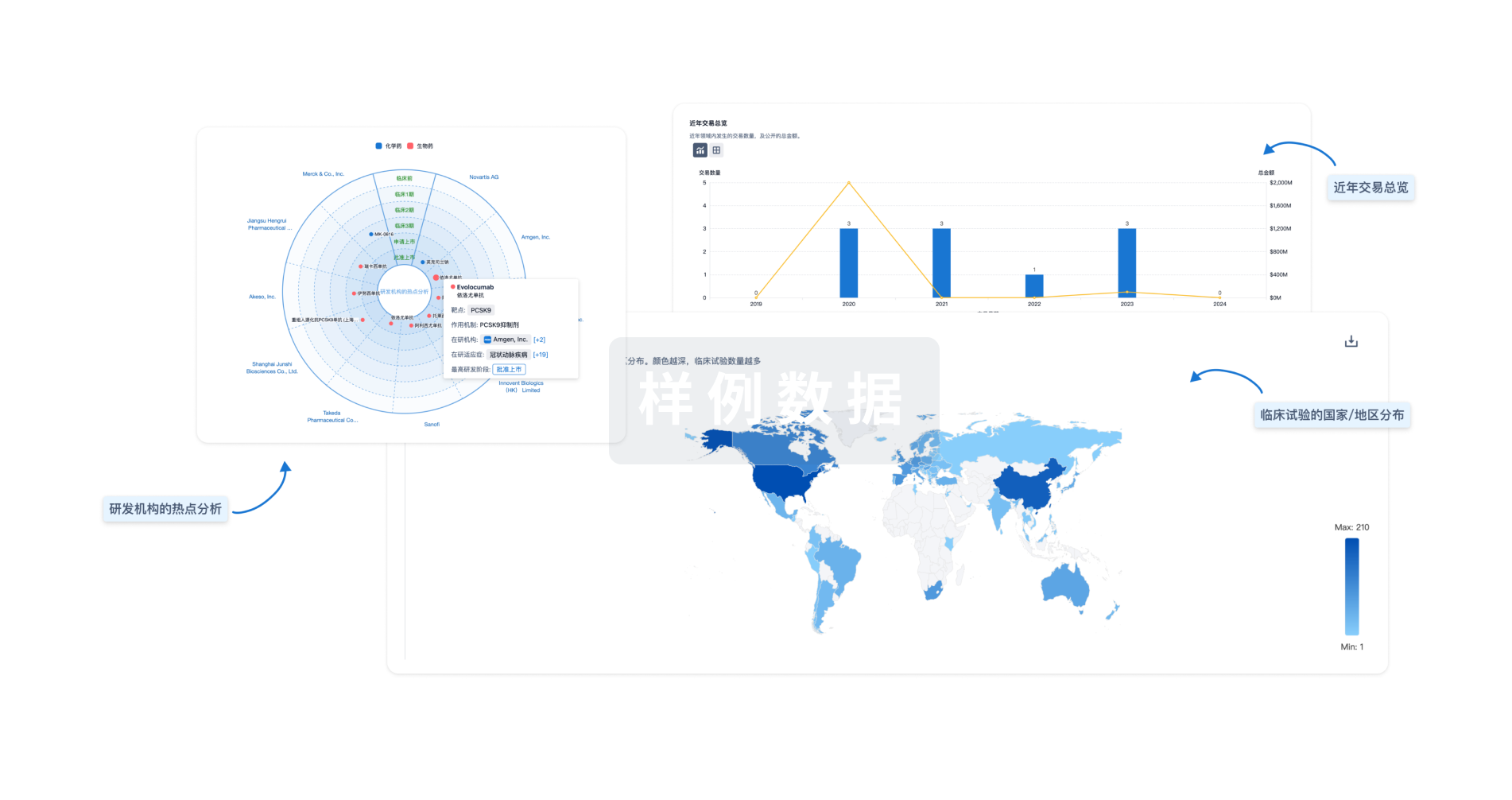预约演示
更新于:2025-05-07
NLRC5
更新于:2025-05-07
基本信息
别名 Caterpiller protein 16.1、CLR16.1、FLJ21709 + [9] |
简介 Probable regulator of the NF-kappa-B and type I interferon signaling pathways. May also regulate the type II interferon signaling pathway. Plays a role in homeostatic control of innate immunity and in antiviral defense mechanisms. |
关联
100 项与 NLRC5 相关的临床结果
登录后查看更多信息
100 项与 NLRC5 相关的转化医学
登录后查看更多信息
0 项与 NLRC5 相关的专利(医药)
登录后查看更多信息
325
项与 NLRC5 相关的文献(医药)2025-03-01·Cardiovascular Toxicology
NLRC5 in Macrophages Promotes Atherosclerosis in Acute Coronary Syndrome by Regulating STAT3 Expression
Article
作者: Liang, Weijie ; Li, Jianhao ; Zhao, Shanjun ; Wang, Dayu ; Chen, Jun ; Chen, Guoqin
2025-03-01·Computers in Biology and Medicine
Blood transcriptomics identifies FEZ1 as a potential biomarker for inflammatory bowel disease
Article
作者: Mokaram Doust Delkhah, Arman
2025-03-01·Mitochondrion
Mitochondrial DNA (mtDNA) accelerates oxygen-glucose deprivation-induced injury of proximal tubule epithelia cell via inhibiting NLRC5
Article
作者: Ge, Guojun ; Yu, Zhenfei ; Zhu, Keqing ; Zhu, Xiaofeng ; Cheng, Mengshi ; Zhu, Bocheng
10
项与 NLRC5 相关的新闻(医药)2024-12-26
·药时空
概要
2024年,曹雪涛团队在Cancer Cell,Nature Communications 及PNAS 等杂志发表了20篇文章,iNature选择了比较代表性的15篇。
第一篇
2024年12月12日,中国医学科学院/北京协和医学院曹雪涛团队在Cell子刊Trends In Immunology 在线发表题为“Biomolecular condensates: phasing in regulated host-pathogen interactions”的综述文章,该综述总结了对生物分子凝聚物如何重塑膜结合细胞器、影响感染诱导的细胞死亡、被病原体劫持生存以及它们如何调节哺乳动物先天免疫的理解的最新进展。该综述讨论了在宿主-病原体相互作用和传染病期间生物分子凝聚物形成失调的影响,并提出了针对此类感染开发潜在治疗方法的未来方向。
参考消息:
https://www.cell.com/trends/immunology/abstract/S1471-4906(24)00295-3
第二篇
2024年12月12日,南开大学/中国医学科学院曹雪涛团队在Cancer Cell(IF=48.8)在线发表题为“Inhibiting intracellular CD28 in cancer cells enhances antitumor immunity and overcomes anti-PD-1 resistance via targeting PD-L1”的研究论文,该研究发现抑制癌细胞细胞内CD28可以增强抗肿瘤免疫,并通过靶向PD-L1克服抗PD-1耐药性。
该研究通过在三阴性乳腺癌(TNBC)小鼠模型中进行体内全基因组CRISPR功能缺失筛查,发现Cd28在癌细胞中促进免疫逃逸的非经典功能。在癌细胞中敲除Cd28增加了I型常规DC(cDC1)的浸润并激活了肿瘤特异性CD8+ T细胞,药物诱导的Cd28敲除抑制了预先建立的肿瘤生长并克服了体内抗PD-1耐药性。此外,人类TNBC组织中癌细胞CD28的高表达与PD-L1表达升高、CD8+ T细胞浸润减少和预后不良相关。机制上,细胞内CD28直接结合Cd274 mRNA,募集剪接体因子SNRPB2稳定细胞核内Cd274 mRNA,促进PD-L1表达和免疫逃逸。因此,破坏癌细胞CD28介导的免疫逃逸可能提供一种改善乳腺癌免疫治疗的潜在途径。
参考消息:
https://www.cell.com/cancer-cell/fulltext/S1535-6108(24)00443-4
第三篇
2024年11月25日,中国医学科学院/北京协和医学院/南开大学曹雪涛团队在Nature Communications(IF=14.7)在线发表题为“Promotion of TLR7-MyD88-dependent inflammation and autoimmunity in mice through stem-loop changes in Lnc-Atg16l1”的研究论文。该研究表明Lnc-Atg16l1的茎环改变促进小鼠TLR7-MyD88依赖性炎症和自身免疫。该研究通过iCLIP-seq鉴定了TLR7结合的长链非编码RNA Lnc-Atg16l1,并发现它在各种类型的免疫细胞中促进TLR7和其他MyD88依赖的TLR信号传导。在小鼠SLE模型中,Lnc-Atg16l1的缺失会减弱相关自身免疫表型的发展。
在机制上,Lnc-Atg16l1与TLR7在U84附近的碱基结合,与MyD88在A129附近的碱基结合。Lnc-Atg16l1原位结构分析表明,它作为TLR7激活后的分子支架,通过特异性茎环结构变化,加强TLR7的TIR结构域与MyD88的相互作用,促进TLR7下游信号转导。因此,该研究发现宿主RNA通过其结构变化调控先天信号和自身免疫性疾病的机制。这些发现以结构依赖的方式提供了对自身RNA促炎功能的见解,并提出了TLR相关自身免疫性疾病的潜在靶点。
参考消息:
https://www.nature.com/articles/s41467-024-54674-4
第四篇
2024年11月21日,南开大学/中国医学科学院/北京协和医学院曹雪涛团队在Proceedings of the National Academy of Sciences (PNAS )在线发表题为“Identification of FBLL1 as a neuron-specific RNA 2'-O-methyltransferase mediating neuronal differentiation”的研究论文,该研究发现FBLL1样蛋白1 (FBLL1)是一种2′-O-甲基转移酶,并发现其促进神经元分化的功能。
该研究发现FBLL1是一个关键的snoRNP复合酶,在体外和体内都能将甲基转移到底物RNA上。此外,FBLL1表现出不同于FBL的2′-O-甲基转移酶位点选择性和组织特异性分布。FBLL1优先在大脑中表达,特别是在人类神经元细胞中,并通过GAP43信使RNA (mRNA)的2′-O-甲基化促进神经元分化。敲除FBLL1,而不敲除FBL,可降低GAP43 mRNA中2′-O-甲基化水平,降低GAP43蛋白的表达,最终抑制神经元分化。总之,该研究发现神经元特异性FBLL1增加了对神经生物学中RNA修饰的见解,并为理解健康和疾病中的2′-O-甲基化提供了线索。
参考消息:
https://www.pnas.org/doi/10.1073/pnas.2406961121
第五篇
2024年10月18日,海军军医大学刘娟、曹雪涛等在Nature Metabolism(IF=18.9)在线发表题为“Farnesyl pyrophosphate potentiates dendritic cell migration in autoimmunity through mitochondrial remodelling”的研究论文,该研究表明法尼基焦磷酸通过线粒体重构增强自身免疫中的树突状细胞迁移。
在这里,研究人员证明了甲羟戊酸途径的中间体法尼基焦磷酸(FPP)在系统性红斑狼疮(SLE)小鼠的mig-DCs中积累。FPP通过协调蛋白香叶酰化和线粒体重构,促进dLNs中mig-DCs的存活和生发中心反应。在机制上,FPP依赖的RhoA香叶基香叶基化通过线粒体RhoA-MFN相互作用促进线粒体融合和氧化呼吸,从而促进内质网应激在mig-DCs中的解决。辛伐他汀是甲羟戊酸途径的一种化学抑制剂,可恢复mig-DCs的线粒体功能,并改善SLE小鼠的全身发病机制。该研究揭示了FPP通过重编程线粒体结构和代谢在决定mig-DCs存活中的关键作用,为DCs依赖性自身免疫性疾病的发病机制提供了新的见解。
原文链接:
https://www.nature.com/articles/s42255-024-01149-x
第六/七篇
2024年10月16日,南开大学,中国医学科学院/北京协和医学院,华大基因,昌平实验室及广州实验室等多单位合作,曹雪涛,汪建、刘龙奇、秦川、任仙文及钟南山等团队合作在Cell Discovery 在线发表题为“Single-cell spatiotemporal analysis of the lungs reveals Slamf9+ macrophages involved in viral clearance and inflammation resolution”的研究论文,该研究分析了叙利亚SARS-CoV-2感染仓鼠模型严重肺炎自然恢复2周内肺部的时空变化。该研究发现SARS-CoV-2感染多种细胞类型,并在早期引起大量细胞死亡,包括肺泡巨噬细胞。该研究鉴定了一组单核细胞来源的Slamf9+巨噬细胞,它们在SARS-CoV-2感染后被诱导,并对SARS-CoV-2引起的损伤具有抗性。Slamf9+巨噬细胞含有SARS-CoV-2,招募Isg12+Cst7+中性粒细胞并与之相互作用以清除病毒。病毒清除后,Slamf9+巨噬细胞分化为Trem2+和Fbp1+巨噬细胞,参与后期炎症消退,最终补充肺泡巨噬细胞。这些发现在SARS-CoV-2感染的hACE2小鼠模型中得到了验证,并得到了公开的人体尸检单细胞RNA-seq数据的证实,证明了Slamf9+巨噬细胞及其与中性粒细胞的协调在损伤后组织修复和炎症消退中的潜在作用。
2024年10月16日,南开大学,中国医学科学院/北京协和医学院,华大基因,昌平实验室及广州实验室等多单位合作,曹雪涛,汪建、刘龙奇、秦川、任仙文及钟南山等团队合作在Cell Discovery 在线发表题为“Single-cell spatiotemporal analysis reveals alveolar dendritic cell–T cell immunity hubs defending against pulmonary infection”的研究论文,该研究将免疫制图技术应用于SARS-CoV-2感染的叙利亚仓鼠模型,这是一种高分辨率技术,通过反卷积和共定位分析整合了空间和单细胞RNA测序(scRNA-seq)。该研究以25只仓鼠的142,965个细胞和45个肺叶为样本,在器官尺度和单细胞分辨率上绘制了从生理状态、感染起始、严重肺炎到自然恢复的肺部感染全过程的综合转录组图。综合分析发现肺泡树突状细胞-T细胞免疫中枢,其中Ccr7+Ido1+树突状细胞、Cd160+Cd8+ T细胞和Tnfrsf4+Cd4+ T细胞生理性共定位,在SARS-CoV-2感染期间迅速扩张,借助Slamf9+巨噬细胞消除SARS-CoV-2,然后在病毒清除后恢复到生理水平。总之,该研究在正常和SARS-CoV-2感染的hACE2小鼠模型以及公开的人类scRNA-seq数据集中验证了这些细胞亚群在免疫中心的存在,证明了该研究的发现在肺免疫中的潜在广泛相关性。
参考消息:
https://www.nature.com/articles/s41421-024-00734-4
https://www.nature.com/articles/s41421-024-00733-5
第八篇
2024年10月14日,中国医学科学院曹雪涛团队在Journal of Hematology & Oncology(IF=29.5)在线发表题为“NPM1 inhibits tumoral antigen presentation to promote immune evasion and tumor progression”的研究论文,该研究发现NPM1抑制肿瘤抗原呈递,促进免疫逃避和肿瘤进展。
在各种人类肿瘤中,高水平的NPM1表达预示着低存活率。NPM1的缺失抑制了肿瘤的进展,提高了荷瘤小鼠的存活率。Npm1缺陷肿瘤显示CD8+ T细胞浸润和激活增加,同时免疫抑制细胞的存在减少。Npm1缺乏增加MHC-I和MHC-II分子和特异性T细胞杀伤。从机制上讲,NPM1与转录因子IRF1结合,然后隔离IRF1与Nlrc5和Ciita启动子的结合,抑制肿瘤细胞中IRF1介导的MHC-I和MHC-II分子的表达。综上所述,肿瘤固有的NPM1通过抑制IRF1介导的抗原呈递来促进肿瘤免疫逃避,从而损害肿瘤免疫原性并重新编程免疫抑制TME。该研究确定NPM1是改善癌症免疫治疗的潜在靶点。
参考消息:
https://jhoonline.biomedcentral.com/articles/10.1186/s13045-024-01618-6
第九篇
2024年5月20日,军事科学院李慧艳、张宇程及周涛共同通讯在Cell 在线发表题为“Innervation of nociceptor neurons in the spleen promotes germinal center responses and humoral immunity”的研究论文,该研究证明了伤害感觉神经纤维沿着血管广泛支配脾脏并到达B细胞区。脾神经支配的伤害感受器主要来源于左侧T8-T13背根神经节(DRGs),促进脾生发中心(GC)反应和体液免疫。伤害感受器可通过抗原诱导的脾前列腺素E2 (PGE2)积聚而被激活,释放降钙素基因相关肽(CGRP),进一步促进早期脾GC反应。在机制上,CGRP通过其受体CALCRL-RAMP1通过环AMP (cAMP)信号通路直接作用于B细胞。通过摄取辣椒素激活伤害感受器可增强脾GC反应和抗流感免疫。总之,该研究建立了一个特定的DRG-脾脏感觉神经连接,促进体液免疫,这表明通过靶向伤害神经系统来改善宿主防御的有希望的方法。
2024年10月1日,曹雪涛团队在Trends in Neurosciences 在线发表题为“Splenic nociceptive neural connection promotes humoral immunity”的述评文章,指出该研究揭示了小鼠左T8-T13背根神经节(DRGs)中脾脏神经支配的伤害感受器群体。该研究发现了一种特殊的DRGs-脾脏感神经连接,通过CGRP-CALCRL/RAMP1轴促进体液免疫,为局部微环境中的免疫调节提供了一个有价值的靶点。
原文链接:
https://www.cell.com/cell/abstract/S0092-8674(24)00453-7
https://www.cell.com/trends/neurosciences/abstract/S0166-2236(24)00180-2
第十篇
2024年8月8日,海军军医大学/中国医学科学院/北京协和医学院/南开大学曹雪涛团队合作在Cell Reports 在线发表题为”The deubiquitinase BAP1 and E3 ligase UBE3C sequentially target IRF3 to activate and resolve the antiviral innate immune response“的研究论文,该研究发现BRCA1相关蛋白-1 (BAP1)和泛素蛋白连接酶E3C (UBE3C)是病毒感染期间控制IRF3稳定性的关键去泛素酶和泛素酶。
在早期阶段,BAP1主导并去除细胞核中与K48相关的IRF3泛素化,阻止其蛋白酶体降解并促进有效的干扰素(IFN)-β的产生。在后期,由IFN-β诱导的E3连接酶UBE3C特异性介导IRF3泛素化并促进其蛋白酶体降解。总的来说,与BAP1和UBE3C的顺序相互作用控制了IRF3在先天反应中的稳定性,确保了有效的病毒清除和炎症消退。总之,该研究的发现提供了对先天信号的时间控制的见解,并提出了对病毒感染的潜在干预措施。
参考消息:
https://doi.org/10.1016/j.celrep.2024.114608
第十一篇
2024年6月21日,中国医学科学院/北京协和医学院曹雪涛及姜明红共同通讯在Advanced Science 在线发表题为“E3 Ubiquitin Ligase RNF13 Suppresses TLR Lysosomal Degradation by Promoting LAMP-1 Proteasomal Degradation”的研究论文,该研究通过筛选调节内溶酶体酸化的103个E3泛素连接酶,发现溶酶体RNF13抑制溶酶体成熟,促进巨噬细胞内体Toll样受体(TLRs)介导的炎症反应。在机制上,RNF13介导K48连接的LAMP-1在K128残基上的多泛素化,用于蛋白酶体降解。TLR激活后,LAMP-1促进溶酶体成熟,从而加速了TLR的溶酶体降解,减少了巨噬细胞中TLR的信号传导。此外,类风湿关节炎(RA)患者外周血单个核细胞(PBMCs)显示RNF13水平升高,LAMP-1表达降低。因此,免疫抑制剂羟氯喹(HCQ)可增加RNF13的多泛素化。综上所述,该研究建立了蛋白酶体和溶酶体降解机制之间的联系,以诱导适当的先天免疫反应,并为靶向细胞内TLRs治疗炎症性疾病提供了一种有希望的方法。
参考消息:
https://onlinelibrary.wiley.com/doi/10.1002/advs.202309560
第十二篇
2024年6月21日,中国医学科学院/北京协和医学院/南开大学/海军军医大学曹雪涛团队(徐贺楠和张晓为论文共同第一作者)在Immunity 在线发表题为“Cellular spermine targets JAK signaling to restrain cytokine-mediated autoimmunity”的研究论文,该研究通过对IFN-β激活的巨噬细胞的代谢组学分析和IFN刺激的反应因子报告因子筛选,发现精胺是Janus激酶(JAK)信号传导的代谢产物。精胺直接结合JAK1的FERM和SH2结构域,破坏JAK1-细胞因子受体的相互作用,从而广泛抑制细胞因子IFN-I、IFN-II、白细胞介素(IL)-2和IL-6引发的JAK1磷酸化。
精胺浓度降低的SLE患者外周血单个核细胞(PBMCs)表现出IFN-I和狼疮基因特征的增强。精胺治疗减轻SLE和牛皮癣小鼠的自身免疫发病机制,降低SLE患者单核细胞中的IFN-I信号。研究人员合成了一种精胺衍生物(精胺衍生物1 [SD1]),并证明其具有有效的免疫抑制功能。总之,该研究结果表明精胺是细胞稳态的代谢检查点和控制自身免疫性疾病的潜在免疫抑制分子。
参考消息:
https://www.cell.com/immunity/abstract/S1074-7613(24)00279-6
第十三篇
2024年2月28日,浙江大学/海军军医大学/中国医学科学院/北京协和医学院/南开大学曹雪涛团队在Signal Transduction and Targeted Therapy(IF=39)在线发表题为“Eosinophils promote CD8+ T cell memory generation to potentiate anti-bacterial immunity”的研究论文,该研究表明嗜酸性粒细胞是通过抑制CD8+ T细胞凋亡来产生记忆性CD8+ T细胞所必需的。嗜酸性粒细胞缺陷小鼠表现出CD8+ T细胞记忆反应明显受损,对单核细胞增生李斯特菌(L.m.)感染的抵抗力减弱。
从机制上讲,嗜酸性粒细胞分泌白介素-4 (IL-4)抑制JNK/Caspase-3依赖性CD8+ T细胞凋亡。此外,在体内L.m.感染早期,活跃的嗜酸性粒细胞被募集到脾脏并分泌更多的IL-4来抑制CD8+ T细胞的凋亡。将野生型(WT)嗜酸性粒细胞而非IL-4缺陷型嗜酸性粒细胞过继转移到嗜酸性粒细胞缺陷小鼠中可以恢复受损的CD8+ T细胞记忆反应。总之,该研究表明,嗜酸性粒细胞衍生的IL-4促进CD8+ T细胞记忆的产生,增强对L.m.感染的免疫防御。该研究揭示了嗜酸性粒细胞在记忆T细胞生成中的新辅助作用,并为通过靶向嗜酸性粒细胞和相关细胞因子来增强疫苗效力提供了线索。
原文链接:
https://www.nature.com/articles/s41392-024-01752-0
第十四篇
2024年2月15日,中国医学科学院/北京协和医学院/海军军医大学/南开大学曹雪涛团队在PNAS 在线发表题为“Methyltransferase Setd2 prevents T cell–mediated autoimmune diseases via phospholipid remodeling”的研究论文,该研究发现Setd2,一种组蛋白H3K36三甲基转移酶,抑制Th17的发育,但通过磷脂重塑促进iTreg细胞极化。机制上,Setd2通过直接催化Lpcat4基因启动子H3K36me3,在T细胞中上调溶血磷脂酰胆碱酰基转移酶4 (lysophatidylcholine acyltransferase 4, Lpcat4)的转录表达。Lpcat4介导的磷脂酰胆碱PC(16:0,18:2)的产生反过来限制内质网应激和氧化应激。这些变化降低了HIF-1α的转录活性,从而抑制了Th17,但增强了Treg的发育。与这一调节模式一致,由于Th17/Treg细胞分化不平衡,T细胞缺乏Setd2会加重实验性自身免疫性脑脊髓炎的神经炎症和脱髓鞘。总之,该研究显示Setd2通过磷脂重塑作为T细胞介导的自身免疫的表观遗传制动器,提示治疗神经炎症性疾病的潜在靶点。
参考消息:
https://www.cell.com/immunity/abstract/S1074-7613(24)00279-6
第十五篇
2024年2月12日,中国医学科学院/北京协和医学院/南开大学曹雪涛团队在Nature Communications 在线发表题为”EFHD2 suppresses intestinal inflammation by blocking intestinal epithelial cell TNFR1 internalization and cell death“的研究论文,该研究报道了EF-hand结构域蛋白D2 (EFHD2),在正常肠组织中高表达,但在溃疡性结肠炎患者的肠活检样本中表达降低,保护肠上皮免受TNF诱导的IEC凋亡。EFHD2抑制TNF诱导的原发性IECs和肠类器官(enteroid)的凋亡。IECs中缺乏Efhd2的小鼠表现出过度的IEC死亡和加重的实验性结肠炎。机制上,EFHD2与Cofilin相互作用,抑制Cofilin磷酸化,从而阻断TNF受体I (TNFR1)内化,抑制IEC凋亡,从而保护肠道免受炎症。总之,该研究发现加深了对EFHD2作为膜受体运输的关键调节因子的理解,为死亡受体信号和自身炎症疾病提供了见解。
参考消息:
https://www.nature.com/articles/s41467-024-45539-x
识别微信二维码,可添加药时空小编
请注明:姓名+研究方向!
信使RNA临床研究
2024-11-24
先天免疫系统利用 PRRs 识别病原体和损伤相关分子模式(PAMPs 和 DAMPs),激活免疫信号通路,产生细胞因子应对感染和组织损伤,其中 NLRs 是重要的胞质 PRRs 家族,也是参与细胞死亡调节的重要分子。 NLR 家族的多样性与结构
起源与进化:NLRs 在植物免疫中具有重要作用,其基因数量和排列多样,随进化不断演变,在不同物种中数量差异大,反映其对生存的重要性。
结构域组成:NLRs 含 N 端效应结构域、中央核苷酸结合结构域(NACHT)和 C 端亮氨酸富集重复序列(LRR),不同亚家族的 N 端结构域不同,决定其功能,如 NLRA 含酸性反式激活结构域(AD),NLRB 含杆状病毒凋亡抑制蛋白重复序列(BIR)等。NLRs 的分类与功能
NLRA 亚家族(以 CIITA 为例):CIITA 是 MHC II 类基因表达的关键转录调节因子,其表达受多种因素调控,影响先天和适应性免疫反应,与多种疾病相关。
NLRB 亚家族(以 NAIPs 为例):人类有 1 个,小鼠有 7 个(Naip3 为假基因),可检测细菌 III 型分泌系统(T3SS)和鞭毛蛋白,与 NLRC4 协同激活炎症小体,引发炎症反应,其突变与脊髓性肌肉萎缩症有关。
NLRC 亚家族(包括 NOD1、NOD2、NLRC3、NLRC4、NLRC5)
NOD1 和 NOD2:最早被表征,对细菌肽聚糖片段识别重要,激活 NF - κB 和 MAPK 信号通路,引发炎症反应,其突变与多种疾病相关,如 NOD2 突变与克罗恩病等炎症性肠病有关。
NLRC3:负调控 NF - κB 和 STING 介导的 IFN 信号,抑制细胞增殖,对维持免疫稳态重要,在多种疾病中发挥作用。
NLRC4:对革兰氏阴性菌感染响应,与 NAIPs 合作激活炎症小体,诱导细胞焦亡,在细菌感染防御、炎症和癌症中具有重要作用,突变可导致自身炎症性疾病。
NLRC5:高度表达于造血细胞,调节 MHC I 类基因表达,影响 CD8 + T 细胞激活,在癌症免疫逃避中有作用,其多态性与慢性牙周炎和肺曲霉病易感性有关。
NLRP 亚家族(包含多个成员,如 NLRP1、NLRP3 等)
NLRP1:最早发现可组装炎症小体,在多种细胞中表达,突变与皮肤和全身炎症性疾病相关,其激活受多种机制调控,包括蛋白水解、与配体结合等。
NLRP3:研究广泛,与多种疾病相关,激活机制复杂,涉及两步过程(启动和激活),受多种因素调节,如 PAMPs、DAMPs、离子通量、细胞器变化等,还与其他 NLRs 和非 NLR 传感器相互作用形成网络。
NLRP6:在肝细胞和肠上皮细胞中高表达,调节炎症和组织修复,参与肠道微生物群稳态维持,在感染和疾病中发挥作用,可通过多种机制激活炎症小体。
NLRP9:在生殖系统中高度表达,在小鼠中参与抗病毒免疫和急性肺损伤,人类中其炎症小体形成和功能需进一步研究。
NLRP12:负调控炎症,可作为炎症小体传感器,在感染防御和炎症调节中发挥重要作用,突变与自身炎症性疾病相关。
其他 NLRPs(如 NLRP4、NLRP7、NLRP10、NLRP11 等):表达广泛,功能多样,部分参与生殖过程,部分在炎症和免疫调节中发挥作用,具体机制和功能有待进一步研究。
NLRX 亚家族(以 NLRX1 为例):定位于线粒体,对线粒体抗病毒免疫有调节作用,影响 NF - κB 和 JNK 信号通路,参与自噬和抗病毒反应调节,其在疾病中的作用尚不完全清楚。NLR 网络与细胞死亡NLR 网络概念
植物中的 NLR 网络:植物 NLRs 通过多种连接方式形成网络,如 guard 和 decoy 模型,在免疫防御中发挥关键作用,抵御病原体效应蛋白攻击,部分 NLRs 功能分化,有传感器和辅助 NLRs 之分,网络具有功能冗余性。哺乳动物中的 NLR 网络
NAIP - NLRC4 网络:在哺乳动物中,NAIPs 作为传感器 NLR,识别细菌配体后与辅助 NLR NLRC4 相互作用,激活炎症小体,诱导细胞焦亡,在细菌感染防御中起重要作用,不同物种中 NAIPs 的传感能力和表达调控有所差异。
NLRP3 相关网络:NLRP3 作为关键辅助 NLR,与多种传感器 NLRs(如 NLRP1、NLRC4、ZBP1 等)及非 NLR 传感器相互作用,形成网络,在不同细胞类型和条件下,参与炎症反应和细胞死亡调控,其激活机制复杂,可能是对多种刺激的综合响应。NLRs 与细胞死亡途径的交叉互作
炎症小体与凋亡、坏死的关联:炎症小体激活可引发细胞焦亡,同时与凋亡、坏死途径存在广泛交叉互作,如 NLRC4 和 NLRP3 炎症小体激活可诱导凋亡相关 caspase - 7 或 PARP1 活化,炎症小体还可通过多种方式影响线粒体凋亡途径,此外,细胞死亡成分间存在功能冗余,如 ASC 在 caspase - 1 缺失时可与 caspase - 8 相互作用诱导细胞死亡,caspase - 8 也可调节炎症小体活性。PANoptosome 与 PANoptosis
PANoptosome 复合物的组成与功能:NLRs 和炎症小体是 PANoptosome 复合物的关键组成部分,该复合物可激活多种 caspases 和 RIPKs,诱导炎症性细胞死亡(PANoptosis),释放细胞因子和 DAMPs,形成多蛋白复合物,在免疫反应和疾病中发挥重要作用,目前已鉴定出多种 PANoptosome 复合物,如 ZBP1 - PANoptosome、RIPK1 - PANoptosome、NLRP12 - PANoptosome 和 AIM2 - PANoptosome 等。 NLRs 在疾病中的作用NLRP3 与疾病
在炎症和代谢疾病中的作用:NLRP3 炎症小体激活释放炎症因子,与肥胖、糖尿病、动脉粥样硬化、心血管疾病、痛风等代谢疾病及阿尔茨海默病、帕金森病等神经退行性疾病密切相关,在炎症性肠病和癌症中的作用具有复杂性,既有促炎致病作用,也有宿主防御功能,其异常激活可导致细胞因子风暴和组织损伤。
治疗靶向 NLRP3:多种化合物可抑制 NLRP3 炎症小体或其相关信号通路,如 MCC950 等,但部分药物存在局限性,如 MCC950 有潜在肝毒性,目前尚无 FDA 批准的特异性 NLRP3 抑制剂用于临床,其他抑制 IL - 1β 信号通路的药物已获批用于多种炎症性疾病。其他 NLRs 与疾病
NLRC4:增益 - 功能突变可致巨噬细胞活化综合征等自身炎症性疾病,在细菌感染防御中至关重要,如对沙门氏菌等感染的免疫反应,其缺失或突变会增加感染易感性,在炎症性肠病和癌症中也有重要作用。
NLRP6:在细菌和病毒感染防御中发挥作用,可调节肠道微生物群稳态,影响肠道上皮屏障完整性和炎症反应,对维持肠道健康和预防炎症相关疾病具有重要意义。
NLRP12:突变与家族性寒冷自身炎症综合征(FCAS2)及成人自身炎症性疾病相关,在感染防御中起关键作用,如对鼠疫耶尔森菌和疟原虫感染的免疫反应,还参与肠道炎症调节和 PANoptosis 诱导,与多种疾病相关。。未来研究方向
未来研究应聚焦于 NLRs 与配体相互作用机制、NLR 网络功能冗余性、NLRs 在不同器官和细胞类型中的作用,以及利用 NLRs 作为生物标志物等方面,这些研究将有助于深入理解先天免疫机制,为疾病诊断、治疗和个性化医疗提供新方向。
微生物疗法
2024-10-25
·生物探索
脑转移(BrM)是一种癌细胞从身体其他部位转移到大脑的现象,原发性癌症转移至大脑的最常见类型是肺癌、乳腺癌等,BrM可能发生在原发性癌症治疗后数月甚至数年,BrM患者的生存期较短。到目前为止,BrM的免疫逃避机制仍不清楚。
近日,来自美国德克萨斯大学MD安德森癌症中心的Dihua Yu研究团队在Nature Cell Biology上发表题为Astrocyte-induced Cdk5 expedites breast cancer brain metastasis by suppressing MHC-I expression to evade immune recognition的文章,发现大脑中的星形胶质细胞可以诱导来源于乳腺癌的BrM细胞中Cdk5高表达,Cdk5通过Irf2bp1-Stat1-importin α-Nlrc5通路抑制MHC-I表达和抗原呈递通路,从而促进免疫逃逸和BrM生长,用Cdk5抑制剂RSV单独处理或与免疫检查点抑制剂联合处理可以显著抑制BrM。
研究人员首先比较了21个人类BrM和对应的原发性乳腺癌中Cdk基因的表达,发现在BrM中Cdk5是上调最明显的,并且通过分析数据库发现更高的Cdk5表达与乳腺癌BrM患者更差的生存率相关。为了研究BrM的发展是否需要Cdk5,他们将敲降了Cdk5的乳腺癌细胞注射到小鼠的颈内动脉中诱导BrM,发现与对照相比,注射了Cdk5敲降的乳腺癌细胞的小鼠生存期明显更长。因此,Cdk5促进BrM进展。为了研究其中的机制,他们检测了Cdk5敲降对于BrM微环境的影响,通过单细胞RNA-seq发现与MHC功能和抗原呈递相关的基因表达上调,CD8+肿瘤浸润T细胞也显著增加。为了验证T细胞在BrM中的作用,他们将上述乳腺癌细胞注射到T细胞反应缺陷的裸鼠体内,发现Cdk5敲降组和对照组之间的差别消失。进一步,CD8+T细胞抑制抗体处理也可以抑制Cdk5敲降导致的生存期延长。因此,Cdk5敲降导致的BrM抑制依赖于CD8+ T细胞。
为了检测Cdk5是否促进癌细胞逃逸T细胞,他们将Cdk5敲降的乳腺癌细胞与激活的T细胞共培养,发现Cdk5敲降的乳腺癌细胞更易被杀死,Cdk5促进癌细胞抵抗抗原特异性T细胞杀伤。癌细胞通常通过下调MHC-I表达来进行免疫逃逸,乳腺癌患者中具有更高MHC-I表达水平的通常也具有更长的无复发生存期。他们发现Cdk5敲降或敲除会显著上调MHC-I表达水平,过表达Cdk5会导致MHC-I下调,因此,Cdk5抑制MHC-I表达。Stat1和Nlrc5是调控MHC-I的转录因子,他们发现Cdk5敲降会导致这两个转录因子表达上调,Cdk5通过Stat1-importin α-Nlrc5信号通路抑制MHC-I表达。接下来他们用磷酸蛋白质组筛选了Cdk5的底物中可能调控Stat1的蛋白,鉴定到了Irf2bp1,Cdk5可以直接结合并磷酸化Irf2bp1的第66位丝氨酸,从而抑制Stat1的表达和其第727位丝氨酸的磷酸化,因此,Cdk5通过磷酸化Irf2bp1调控Stat1-importin α-NNlrc5信号通路。接下来他们将新鲜分离的原位肿瘤细胞与对应的BrM细胞进行体外培养,发现体外培养6天后BrM细胞中Cdk5的高表达消失了,说明脑部的肿瘤微环境调控Cdk5的表达,进一步分析发现是星形胶质细胞通过分泌emilin-1诱导了BrM细胞中Cdk5的高表达。最后他们发现用Cdk5抑制剂RSV处理小鼠可以通过恢复MHC-I表达和增强T细胞反应延缓BrM生长,并且还进行了临床前实验,发现用RSV和PD-1抑制剂联合用药可以抑制乳腺癌BrM。
总的来说,这项研究揭示了星形胶质细胞诱导乳腺癌来源的BrM细胞中Cdk5高表达,抑制MHC-I表达,促进免疫逃逸和脑转移,为将来临床上通过靶向Cdk5提高肿瘤免疫疗法的效果和治疗脑转移肿瘤提供了相关理论基础。
参考文献
https://doi.org/10.1038/s41556-024-01509-5
内容来源于网络,如有侵权,请联系删除。
分析
对领域进行一次全面的分析。
登录
或

生物医药百科问答
全新生物医药AI Agent 覆盖科研全链路,让突破性发现快人一步
立即开始免费试用!
智慧芽新药情报库是智慧芽专为生命科学人士构建的基于AI的创新药情报平台,助您全方位提升您的研发与决策效率。
立即开始数据试用!
智慧芽新药库数据也通过智慧芽数据服务平台,以API或者数据包形式对外开放,助您更加充分利用智慧芽新药情报信息。
生物序列数据库
生物药研发创新
免费使用
化学结构数据库
小分子化药研发创新
免费使用